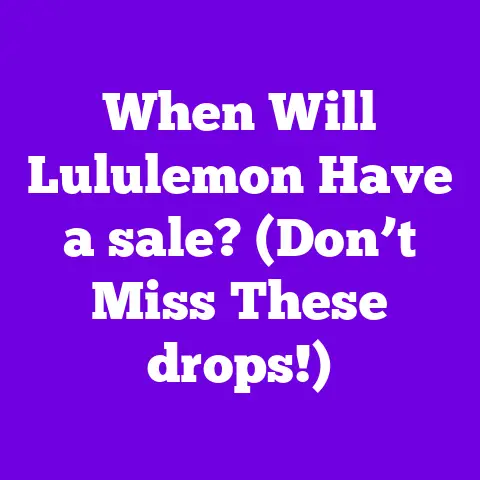sales Slumping? (Act Now, Boost Revenue!)
Have you ever found yourself puzzled by a sudden drop in sales, despite having a solid product and a loyal customer base?
You’re not alone.
According to a recent study by the National Retail Federation, nearly 70% of businesses experience a sales downturn at some point in their operational life.
This staggering statistic underscores a pressing issue that many business owners, like myself, may face.
Imagine a thriving café that has garnered a loyal following over the years.
Regulars come in every morning for their favorite coffee, and the place buzzes with the chatter of satisfied customers.
Then, seemingly overnight, foot traffic dwindles, online orders plummet, and the once-vibrant atmosphere turns somber.
The owner, perplexed and worried, wonders: Where did it all go wrong?
This scenario is not merely hypothetical; it’s a reality for many businesses that experience the harrowing phenomenon of slumping sales.
Understanding the causes behind this decline is not just a matter of curiosity; it is crucial for survival.
In this article, I will explore the various reasons for declining sales, the implications it has on businesses, how to identify warning signs, and actionable strategies to boost revenue.
The urgency to act cannot be overstated—businesses must revitalize their sales strategies before it’s too late.
Understanding the Causes of Slumping Sales
Market Dynamics
Sales slumps can often be traced back to shifts in market dynamics.
As consumers, we are influenced by myriad factors including economic conditions, technological advancements, and changing preferences.
For instance, the COVID-19 pandemic brought about a seismic shift in consumer behavior.
Many brick-and-mortar stores saw a drastic decline in foot traffic as people turned to online shopping.
According to eMarketer, U.S.
e-commerce sales grew by 32.4% in 2020, indicating a significant pivot in consumer shopping habits.
Furthermore, economic downturns can lead to decreased disposable income, prompting consumers to cut back on non-essential spending.
For instance, during the 2008 financial crisis, many retailers struggled as consumers prioritized essentials over luxuries.
The inability to adapt to these market dynamics can lead to a downward spiral in sales.
Internal Factors
However, it’s not just external forces that can lead to slumping sales; internal factors also play a critical role.
Poor management practices, lack of innovation, or ineffective marketing strategies can all contribute to a decline.
For example, consider the case of Blockbuster, which failed to adapt to the digital age and lost its market share to competitors like Netflix.
Their reluctance to innovate and embrace new technologies ultimately led to their demise.
Moreover, internal communication problems can hinder a company’s ability to respond to market changes.
If teams are not aligned on goals or if there is a lack of clear direction, it can result in disjointed efforts that fail to resonate with customers.
Competitive Landscape
In an increasingly competitive marketplace, businesses must also contend with the threat of saturation.
As more players enter the market, the competition becomes fiercer, which can dilute market share and lead to reduced sales.
For instance, the fast-casual dining sector has seen an explosion of new entrants, making it challenging for established brands to maintain their customer base.
Companies like Panera Bread, once a leader in the fast-casual space, have had to innovate continuously to fend off competitors.
The pressure to differentiate in a crowded market can lead to slumping sales if businesses fail to keep pace with evolving consumer preferences and competitive strategies.
The Implications of Declining Sales
The consequences of slumping sales can be far-reaching, affecting various aspects of a business’s health.
Initially, there may be short-term effects such as cash flow issues.
Limited revenue can hamper a company’s ability to pay bills, invest in marketing, or hire new employees.
This financial strain can lead to a vicious cycle where businesses are forced to make cutbacks, which can further exacerbate their sales slump.
Additionally, employee morale can take a hit.
A workforce that feels the pressure of declining sales may become disengaged, leading to decreased productivity and higher turnover rates.
This, in turn, can create a toxic work environment where innovation and creativity are stifled.
Long-term implications can be even more severe.
A brand’s reputation can suffer if customers perceive it as struggling or failing.
Negative reviews and diminished trust can make it harder to win back lost customers or attract new ones.
Companies that neglect the warning signs of declining sales risk falling into obscurity, as illustrated by the case of Sears, which failed to adapt to the retail landscape and eventually filed for bankruptcy.
Identifying Warning Signs
Recognizing the early warning signs of a sales slump is crucial for timely intervention.
Here’s a checklist of key indicators that may signal a potential decline:
Declining Customer Engagement: Are you noticing fewer interactions from customers, either online or in-person?
A decrease in engagement can indicate that customers are losing interest.Negative Feedback: Are customer reviews becoming increasingly negative?
This could be a sign that your product or service is no longer meeting expectations.Reduced Repeat Business: If loyal customers are not returning, it’s a red flag.
Customers who previously frequented your business should not suddenly disappear.Sales Metrics: Analyze key performance indicators (KPIs) such as average transaction value, conversion rates, and sales growth.
A downward trend in these metrics can indicate a problem.
Encouraging readers to conduct a self-assessment of their sales processes is essential.
I recommend taking a step back and evaluating how your business is performing against these indicators.
Consider the case of a struggling online retailer that noticed an alarming drop in repeat purchases.
By conducting customer surveys, they were able to identify issues related to product quality and customer service.
Acting on this feedback allowed them to make necessary changes and ultimately revitalized their sales.
Actionable Strategies to Boost Revenue
Once the causes and warning signs of slumping sales are identified, it’s time to take action.
Here are several strategies that can help businesses boost revenue:
Revamping Marketing Strategies
A fresh approach to marketing can breathe new life into a business.
Embracing innovative marketing tactics and channels is essential to reach new audiences and re-engage existing customers.
For example, digital marketing has become a cornerstone for many businesses.
Utilizing social media platforms, email marketing, and search engine optimization can help you connect with potential customers where they spend their time.
Consider the success story of a local bakery that turned to Instagram to showcase their products.
By sharing visually appealing images and engaging with followers, they attracted a new customer base and increased foot traffic to their store.
Enhancing Customer Experience
Improving customer service can lead to increased sales.
Personalizing interactions and enhancing the overall customer journey is paramount.
Customers are more likely to return to a business that makes them feel valued and appreciated.
For instance, Zappos, the online shoe retailer, is renowned for its exceptional customer service.
Their commitment to going above and beyond for customers has resulted in a loyal following and repeat business.
Leveraging Data and Analytics
In today’s data-driven world, leveraging analytics can provide valuable insights into customer behavior and preferences.
Businesses that invest in data analytics can make informed decisions that drive sales.
For example, analyzing purchasing patterns can help you identify which products are flying off the shelves and which are gathering dust.
Amazon is a prime example of a company that excels in using data analytics.
By tracking customer preferences and purchase history, they can recommend products that customers are likely to buy, significantly enhancing their sales.
Diversifying Product Offerings
Expanding your product line or services can help meet evolving customer needs.
As consumer preferences change, businesses must be willing to adapt.
For instance, a clothing retailer that traditionally sold only men’s apparel may find new opportunities by introducing a women’s line or branching into accessories.
A successful case study is that of Lego, which diversified its product offerings by creating themed sets based on popular movies and franchises.
This strategy not only attracted new customers but also re-engaged existing ones.
Building Strategic Partnerships
Collaborating with other businesses or influencers can create new revenue opportunities.
Strategic partnerships can expand your reach and introduce your brand to new audiences.
For example, a local gym partnering with a health food store for cross-promotions can bring in new customers for both businesses.
Consider the example of Coca-Cola and McDonald’s.
Their long-term partnership has been mutually beneficial, with both brands benefiting from shared marketing efforts and increased visibility.
Conclusion
In conclusion, the phenomenon of slumping sales is a multi-faceted issue that requires immediate attention.
Understanding the underlying causes, recognizing the implications, and identifying warning signs are crucial steps in reversing the trend.
The strategies outlined—from revamping marketing efforts to enhancing customer experience and leveraging data—are actionable steps that can lead to revitalized revenue.
As business owners and leaders, it is our responsibility to act swiftly and decisively.
I urge you to take a moment and reflect on your own sales practices.
Are you noticing any of the warning signs?
What steps can you take today to assess and improve your sales strategies?
The time to act is now—don’t let your business fall victim to the consequences of inaction.
The road to recovery begins with a single step, and I invite you to take that step today.






